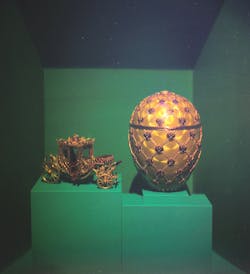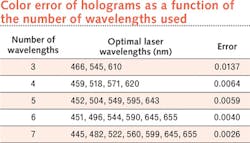
Done correctly, a high-quality photographic-emulsion-based hologram can present a stunning 3D image that closely replicates the appearance of an actual object. To make such a hologram, a laser beam is split into a reference and signal beam—the reference illuminates the emulsion directly and the object beam is bounced off the object, with the resulting light striking the emulsion and creating an interference pattern within it. After development, the emulsion alone, when illuminated only by the reference beam, accurately reproduces the 3D wavefront that originally had bounced off the object.
Such a hologram is usually monochrome, although many attempts have been made, with varying success, to create full-color versions. Now, Hans Bjelkhagen of the North East Wales Institute of Higher Education (Wrexham, Wales) and his colleagues have developed a way to create ultrarealistic full-color, large-depth Denisyuk—or single-beam-reflection—holograms (the Denisyuk method is a particularly simple approach to recording holograms) using silver-halide panchromatic emulsions that have an ultrafine grain of 4–8 nm.1
Rather than referring to them as holograms, Bjelkhagen calls the creations "OptoClones," for the simple reason that the word "hologram" has been incorrectly used to refer to modern versions of "Pepper's Ghost" projections of pop stars (the most famous example being Tupac Shakur) and so on. (Totally unrelated to genuine holography, the Pepper's Ghost technique simply projects an ordinary 2D image that seemingly floats in the air via a large half-silvered reflector—no 3D image is created.).
The accuracy of the new technique opens up new uses for holography—for example, the creation of 3D images of valuable and/or ancient objects that are part of a museum's collection, allowing the hologram to be displayed instead of the object itself, or displayed at a location remote from the object.
Ultrafine-grain emulsion
For the highest quality, Bjelkhagen uses a panchromatic ultrafine-grain silver halide emulsion that was the outcome of a two-year European research project called SilverCross.2 The recording setup used so far is a three-color (red-green-blue) arrangement with the three laser beams coinciding to form a "white" beam, which simultaneously records three holograms in the emulsion. The group has developed a mobile version of their recording equipment that they can take to museums.
Properly created reflection holograms like the OptoClones can be displayed using a spectrally incoherent but spatially tiny source. Such a light source can be a halogen lamp, although the fact that the hologram is actually recorded in three narrow wavelength bands means that most of the spectrum of the halogen lamp is wasted. An ideal approach would be to use three LEDs that match the three correct display wavelengths.
A way to further improve full-color holograms would be to use more recording and display wavelengths to more accurately render the many colors and hues of the real world. For example, the table shows the color error of holograms as a function of the number of wavelengths used from three to seven. The average error was calculated as the rendering of all the different colors on the so-called Macbeth ColorChecker color-rendition chart. Such quality could be needed, for example, to precisely render oil paintings.
To publicize the OptoClone technology, Bjelkhagen's team decided to record several of the famous Faberge Imperial Easter Eggs in the Faberge Museum (St. Petersburg, Russia). The new OptoClones were on display at the International Symposium of Display Holography 2015 (ISDH2015) in St. Petersburg in July 2015 (see figure). The team used a red laser emitting at 638 nm with an output power of 90 mW (Hellenic Institute of Holography HiH-R100 DL laser), a green laser emitting at 532 nm with an output power of 100 mW (Cobolt Samba DPSS laser), and a blue laser emitting at 457 nm with an output power 50 mW (Cobolt Twist DPSS laser). All recordings were done with mobile recording equipment in the museum itself.
In addition, special display cases were made incorporating new RGB LED lights. These cases provide a much better image resolution (because of a smaller source size) as compared with halogen lights. The result is super-sharp, high-contrast holographic images with a very high signal-to-noise ratio, says Bjelkhagen. The museum people and the attendees at the conference "thought they were seeing the Faberge Eggs displayed behind glass and not just an image of them," he notes.
REFERENCES
1. H. I. Bjelkhagen and J. Cook, "Colour holography of the oldest known work of art from Wales," The British Museum Technical Research Bulletin, 4, 87–94 (2010).
2. SilverCross project, European EC FP6 CRAFT project 005901 (2004-2007).

John Wallace | Senior Technical Editor (1998-2022)
John Wallace was with Laser Focus World for nearly 25 years, retiring in late June 2022. He obtained a bachelor's degree in mechanical engineering and physics at Rutgers University and a master's in optical engineering at the University of Rochester. Before becoming an editor, John worked as an engineer at RCA, Exxon, Eastman Kodak, and GCA Corporation.
